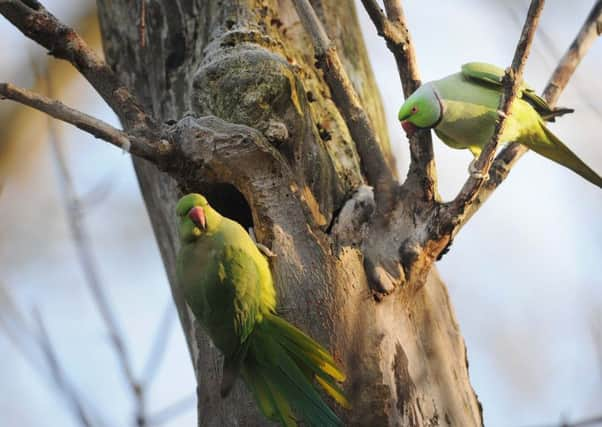Birdwatch: Exotic invasion may pose risks to rivals


Its strongholds here are in London’s suburbs with flocks of 7,000 or more seen coming into roost at some sites while there are now up to 50,000 in the wild with numbers increasing by more than 30 per cent a year.
There are also populations around Manchester, Birmingham and on Merseyside and, although the spread into Yorkshire has been slower, sightings are increasing with several readers reporting individuals visiting garden feeders and a pair with two fledged young seen at Fleets Dam, Barnsley in recent weeks.
Advertisement
Hide AdAdvertisement
Hide AdApart from an isolated record from Norfolk in 1855, the first British pair nested in Kent in 1969. Where they and others came from is unclear, one entertaining but probably untrue story is that some escaped from the set of The African Queen starring Humphrey Bogart and Katherine Hepburn and filmed at Shepperton Studios in 1951.
Whatever the source, ring-necked parakeets are now firmly established as a British bird.
They can be tricky to see properly, flying quickly about the trees with long tails and loud screeching kee-ak cries. They are also hard to watch in the trees; their long thin bodies blending in with the foliage.
Both sexes have leaf green plumage and bright red beaks while the males have black bibs, pink collars and a blueish sheen to the head.
Advertisement
Hide AdAdvertisement
Hide AdSuch a dramatic increase in numbers of any species can cause problems and this might happen with ring-necked parakeets. There is a potential threat to other tree nesting bird species such as starlings, jackdaws, great spotted woodpeckers and nuthatches.
The demand for tree holes to nest in far outstrips the limited supply and the parakeets occupy these about a month earlier than other species.
Studies in Belgium have shown that once parakeets move into a section of woodland, nuthatches, unable to compete for nest holes, move out and there are fears that the same could happen here.
There is also damage to crops and fruit trees. One vineyard near Cobham, Surrey has had its vines stripped bare by a nearby parakeet roost while a roost at Stanwell close to Heathrow Airport is seen as a potential threat to planes.
Advertisement
Hide AdAdvertisement
Hide AdA cull of the parakeets might become necessary but the RSPB is against this. It believes their numbers should only be controlled in places where there has been serious damage to crops or a risk to air safety.
Waders are starting to be seen on return passage with knot, grey plovers and 98 dunlin at Beacon Ponds and the first green sandpipers at Blacktoft Sands and Fairburn Ings.
The little bittern is still at the Old Moor reserve while a female garganey has been seen with three young at Tophill Low. Nine drake common scoters were on Redmires reservoir.